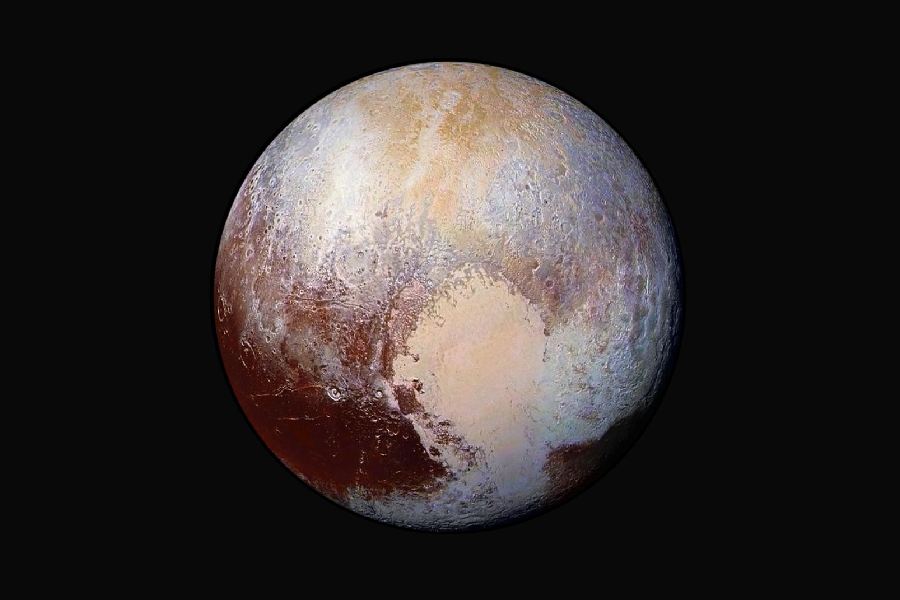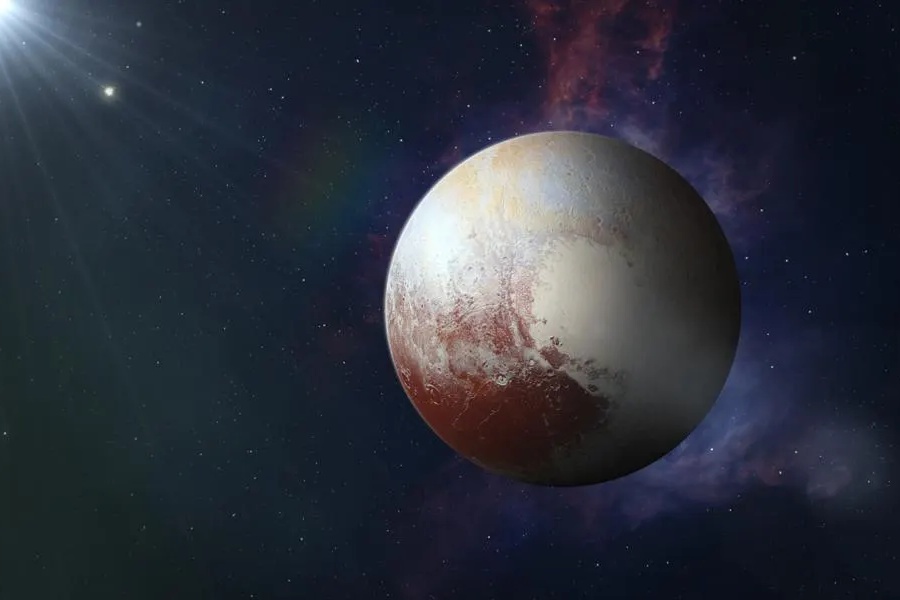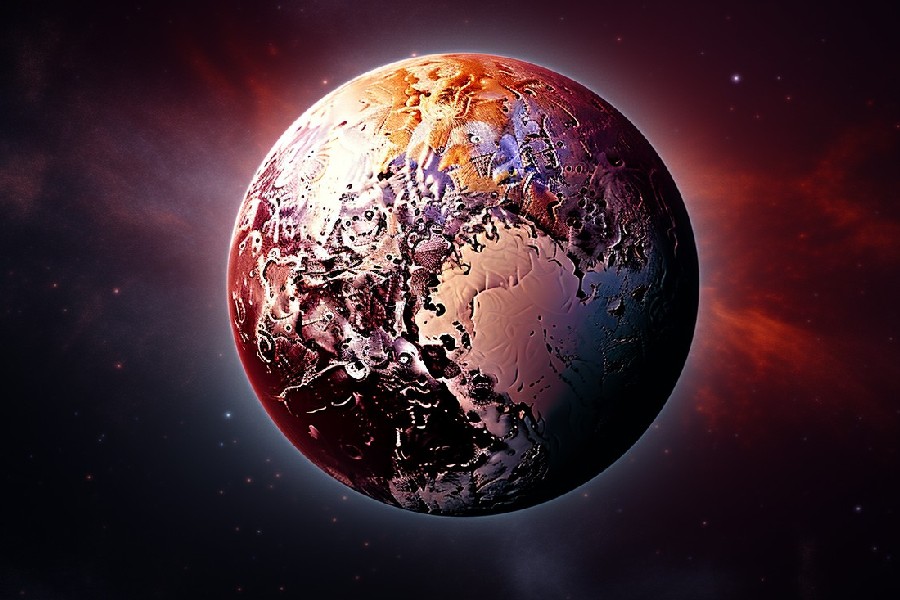Humanity has long gazed upon the night sky in wonder, tracing celestial bodies drifting through the inky blackness of the night sky. Several mysterious planets have stirred our imagination. But few sparked more intrigue than tiny, frozen Pluto, occupying the most distant realms of our solar system. Is Pluto a planet? This question has stirred intense debate among astronomers and the public alike.
That enduring curiosity transformed into debate in 2006 when Pluto’s planetary status was suddenly challenged after discoveries revealed gaps in our cosmic understanding.
Throughout history, the number of known planets in our solar system has fluctuated. Now, in the 21st century, we find ourselves questioning again whether tiny Pluto deserves to be called a planet.
The fierce controversy surrounding Pluto shows how meaningful these labels remain to our collective culture. As we continue exploring our cosmic neighborhood, we may again rethink what it means to be a planet.

Is Pluto a Planet?
So, is Pluto a planet? No, Pluto isn’t considered a planet by the International Astronomical Union (IAU). In 2006, the IAU redefined the criteria for classifying celestial bodies, and Pluto no longer met the criteria for a planet.
Their decision shocked many who grew up considering the distant, icy world to be the ninth planet in our solar system. But with countless objects like Pluto filling the Kuiper belt, astronomers felt they needed a more precise definition of planets.
According to IAU, Pluto is now categorized as a “dwarf planet” in our solar system.
Historical Perspective on Pluto
Pluto’s discovery
In 1930, young astronomer Clyde Tombaugh detected a faint moving speck in the night sky at Lowell Observatory. By comparing photographic plates taken weeks prior, he discerned evidence of an unseen ninth planet orbiting beyond Neptune.
This settled a decades-long debate about anomalies in giant Neptune’s orbit. Pluto’s vast distance and tiny size revealed an icy, diminutive world marking the frontier of the solar system’s outer limits.
Its detection redefined our understanding of what constitutes a planet and hinted at a swarm of other frozen dwarf planets awaiting discovery in the abyss beyond.
Initial classification
Once hailed as the ninth planet in our celestial lineup, Pluto held a revered position. Its discovery captured imaginations worldwide, contributing to the allure of our cosmic neighborhood.
In these early days, our understanding of the solar system was marked by the excitement of exploration. Even the thought, is Pluto a moon passed by some of our minds.
Limited knowledge and the evolving field of astronomy
Pluto’s initial classification reflected the limited knowledge of the time. The evolving field of astronomy in the mid-20th century witnessed discoveries that reshaped our understanding of planetary bodies.
As technology advanced, so did our ability to scrutinize the cosmos, prompting a reevaluation of Pluto’s status. So, what happened to Pluto? Let’s find out!
The Demotion of Pluto
International Astronomical Union’s definition of a planet
In 2006, the IAU redefined the criteria for classifying celestial bodies as planets. According to the new definition, a celestial body must orbit the Sun, be spherical in shape, and have cleared its orbit of other debris. Unfortunately for Pluto, it didn’t meet the last criterion.
Reasons behind Pluto’s reclassification
- Orbit clearance – The primary reason for Pluto’s reclassification was its failure to clear its orbit of other debris, unlike the eight recognized planets.
- Evolving scientific understanding – Advances in astronomy led to a deeper understanding of the solar system. This prompted scientists to reconsider the criteria for planetary status.

Arguments for Pluto’s Planetary Status
Scientific and astronomical perspectives
Despite its small size, some scientists argue Pluto deserves to officially retain its designation as a planet. They argue that Pluto harbors the key spherical shape indicative of a gravitationally collapsed world, unlike the jagged forms of asteroids.
Additionally, it orbits the Sun directly rather than orbiting another planet, following the criteria that qualified it as a bonafide planet upon discovery in 1930.
Moreover, advocates point to the pivotal New Horizons mission, which revealed Pluto’s seasons, geologic complexity, and atmosphere. As per them, this groundbreaking data undermines arguments to reclassify Pluto as a “dwarf” planet and diminish its standing.
Other supporters contend that Pluto’s uniqueness shouldn’t invalidate its planet status, as terrestrial worlds similarly show diversity in rotations, tilts, magnetic fields, and orbital resonances.
Public sentiment and debate
Arguments for Pluto’s planethood also stem from public sentiment, given its longstanding cultural identity as the ninth planet. Many feel strongly that the perceived “demotion” unfairly strips significance rather than embracing the broader context of numerous similar frozen worlds uncovered since 2006.
Sentimentality persists without apology amongst advocates who grew up admiring Pluto for over seven decades as the solar system’s frontier.
Some argue for inclusive definitions that recognize the wide range of planets instead of demoting popular ones. Rather than taking away Pluto’s planet status, creating categories like “dwarf planet” appropriately embraces the diversity of worlds in light of recent discoveries.
Challenges to Pluto’s Planetary Classification
Criticisms of the IAU’s definition
- Orbit-clearing criterion – Critics argue that the orbit-clearing criterion is arbitrary and not uniformly applicable to all celestial bodies. For example, Earth technically doesn’t clear its own orbital zone either.
- Planetary diversity – Some scientists advocate for a more inclusive definition that embraces the diversity of planetary characteristics rather than imposing criteria that eliminate borderline candidates.
- Cultural attachment – Public critics highlight that the IAU’s narrow definition strips away generations of cultural and scientific meaning attached to Pluto as the ninth planet. They argue this fails to balance scientific progress with past meaning.
- Motivations questioned – Those in favor of dwarf planet status have been accused of seeking to reduce their own exploratory search space by reducing the number of planets.
Alternative classifications and perspectives
- Dwarf planet classification – Pluto was reclassified as a “dwarf planet”, a category that recognizes its planetary-like features without meeting all other criteria. But some find this a “lesser” status.
- Spectrum of planets – Some propose classifying border worlds like Pluto as small planets rather than creating a separate dwarf planet category to maintain equal standing.
- Evolving scientific dialogue – Many propose ongoing dialogue to adapt classifications based on new discoveries rather than sticking to restrictive definitions for political or exclusionary motives. The true spectrum of what qualifies as a “planet” is still unfolding.

Pluto’s Unique Characteristics
Orbital traits
Pluto’s orbital dance stands out in the cosmic ballet, marked by its eccentric path around the sun. This unique trajectory not only distinguishes it from its planetary counterparts but also shapes its dynamic relationship with other celestial bodies in our solar system.
Composition
Insights from space missions like New Horizons
The New Horizons probe’s 2015 flyby offered unprecedented insights into Pluto’s composition by directly sampling its terrain.
Findings revealed exotic ices like nitrogen, methane, and carbon monoxide that utterly resculpt the surface in alien glacial flows and sublimation cycles following frigid seasons that can’t be found anywhere else.
Data exposed unexpected complexity – vast oceans of water ice extend into Pluto’s heart beneath the insulating nitrous frost caps, while mineralogies suggest a uniquely enduring internal heat source.
Atmospheric insights
In addition to surface composition, New Horizons also unveiled Pluto’s thin yet surprisingly complex nitrogen-based atmosphere. Its structure shares similarities with Triton and even Mars – hazes of organic molecules high in the atmosphere hint at chemical interplay driven by unfamiliar UV interactions with this distant world’s icy exterior.
Methane, acetylene, and ethylene combine nitrogen to paint a rich atmospheric cocktail distinct from other ice dwarf worlds.
Comparative analysis with other planets and dwarf planets
Comparisons against fellow Kuiper belt denizens, including dwarf planets Eris and Haumea, reveal high concentrations of surface methane ice.
But Pluto’s density, layering and enduring outgassing springs from an anomalous past – likely a hot, melted history giving rise to liquid oceans persisting internally today. This lasting heat supplemented by radioisotopes implies chemical complexity exceeding terrestrial worlds absent on frozen worlds.
Throughout remain signatures of Pluto’s cosmically singular balance marrying extremely low temperatures with pockets of lasting internal warmth – an Earth-like system warped and hardened by a cosmic deep freeze.

Recent findings about Pluto
New Horizons mission (2015)
The New Horizons spacecraft provided unprecedented close-up images and data about Pluto during its historic flyby in 2015, revolutionizing our understanding of this distant icy world.
- Surface features – High-resolution images revealed incredibly diverse landscapes, including vast nitrogen ice plains called Sputnik Planitia, ice mountains like Wright Mons reaching heights over 15,000 feet, and the unique heart-shaped structure Tombaugh Regio composed of puzzling polygon-like cells.
- Geologic activity – Evidence of geological activity on Pluto, like flowing ices and possible cryovolcanoes, reinforces interpretations of a surprisingly dynamic world rather than an inert ice ball.
- Atmospheric characteristics – Data on Pluto’s thin yet multilayered atmosphere, composed chiefly of nitrogen with hazes of tholins and hydrocarbons like methane, taught us about exotic photochemistry and circulation patterns utterly alien to the terrestrial norm.
- Orbital interactions – The discovery of Charon’s state locked in a tidal orbital resonance with Pluto provided insights into the dwarf planets’ intertwined pasts and alignments potentially created by a giant impact.
Ground-based studies
In addition to New Horizons, regular observations from powerful telescopic facilities on Earth contribute to supplementary monitoring of atmospheric changes, surface variations, and the intriguing Plutonian system.
- Seasonal cycles – Ground-based measurements tracked changes in atmospheric pressure and temperatures on Pluto, showing much stronger swings than predicted as seasons shift in its elongated 248-year orbit around the Sun.
- Surface transformations – Astronomers photographed shifting bright patches and darkening on Pluto’s surface, most likely linked to sublimation and refreezing processes altering terrains through seasonal volatile transport.
- Charon details – Using adaptive optics, the largest craters and grooved features on Pluto’s enigmatic moon Charon came into focus from Earth, including cracks in its frozen surface revealing a complex early history.
Subsurface ocean hypothesis
Studies hypothesize a slushy subsurface ocean under Pluto’s ice shell, enabled by long-term radioisotope decay. Confirmation would classify Pluto with active “ocean worlds” like Europa, where hot cores contact vast global seas.
Further evidence supporting this growing theory would compel recategorizing Pluto as a geophysically living world rather than an inert frozen globe.
Dynamic changes
Pluto’s surface changes, including shifting ice and terrain rework, challenge assumptions of geologic inertia. Dark spot variations and bright deposit migrations likely arise from exotic glacial and sublimation cycles rapidly pumping frosts across landscapes.
This active world transforms itself perpetually through cycles of freezing, melting, and weird cryo-tectonics that Earth only experiences in small doses, yet Pluto exhibits them in an intensified manner.
Ongoing Research and Discoveries
Exploration missions and their impact on classification
- Future exploration – Ongoing and future missions, such as proposed orbiter missions to Pluto, could provide further insights into its geological, atmospheric, and internal processes. Advanced instruments on these missions aim to collect comprehensive data to enhance our understanding of Pluto’s characteristics.
- Reevaluation of criteria – Ongoing research and the potential discovery of new features may lead to a reevaluation of the criteria for planetary classification.
- Incorporating new knowledge – If new findings challenge existing criteria, the scientific community may need to adapt classification frameworks to accommodate evolving knowledge.
- Interdisciplinary collaboration – Ongoing research encourages collaboration between astronomers, planetary scientists, and geophysicists, fostering a holistic understanding of Pluto’s nature.
Conclusion
Is Pluto a planet? The Pluto debate has ignited varied perspectives. Some argue for its planetary status, citing historical classifications, while others stress its distinct orbital characteristics. Despite the controversy, it’s crucial to acknowledge ongoing scientific inquiry.
While some champion Pluto’s planetary identity based on historical classifications, others emphasize its unique orbital characteristics. Regardless, the debate highlights the dynamic nature of scientific understanding.
Let’s leave the door open for future revelations. Continuous exploration and technological advancements may offer fresh insights into Pluto’s nature. Science thrives on curiosity, so let’s encourage readers to stay inquisitive about the cosmos and remain open to the evolving narrative of our celestial neighbors.
Frequently Asked Questions
Why was Pluto demoted from being a planet?
In 2006, the International Astronomical Union (IAU) redefined the criteria for classifying celestial bodies.
Pluto, although fitting some criteria, didn’t meet all three conditions: orbiting the Sun, having sufficient mass to assume a nearly round shape, and clearing its orbit of other debris. As Pluto shares its orbit with other objects in the Kuiper belt, it was reclassified as a “dwarf planet”.
What arguments support Pluto’s planetary status?
Scientifically, some argue that Pluto exhibits planet-like characteristics, such as a spherical shape and an atmosphere.
Public sentiment also plays a role, with many expressing a nostalgic attachment to Pluto as the ninth planet. Some astronomers advocate for a broader definition of planets that considers characteristics beyond orbital clearing.
Are there challenges to the International Astronomical Union’s (IAU) definition?
Yes, there are criticisms. Some scientists argue that the criterion of “clearing its orbit” isn’t consistently applied to all planets. Additionally, the discovery of other celestial bodies with similar characteristics has sparked debates about the universality of the IAU’s definition, leading to ongoing discussions within the scientific community.
How does ongoing research impact Pluto’s classification?
Ongoing research, including data from the New Horizons mission and future exploration, contributes to our evolving understanding of Pluto. As new findings emerge, there is a potential for reevaluating planetary classification criteria.
Ongoing interdisciplinary collaboration and technological advancements are key factors influencing the dynamic discussion around Pluto’s planetary status.
